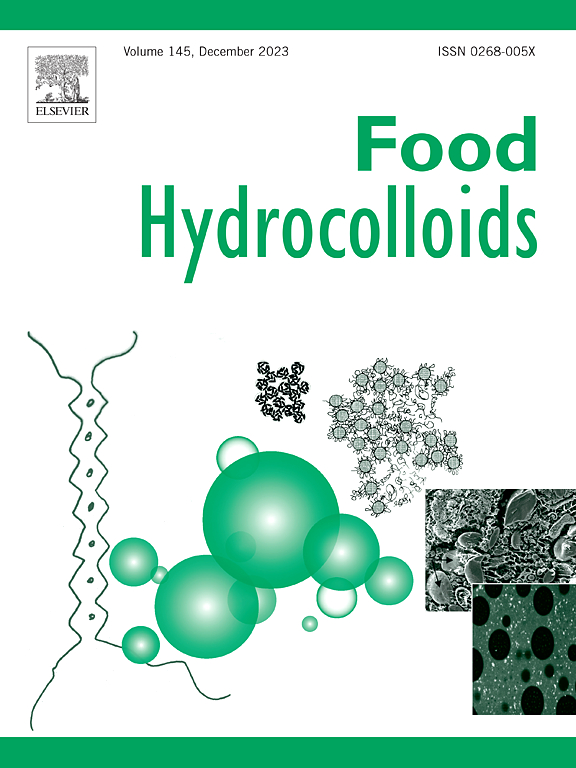Acidic-heating induced protein fibrils derived from perilla seed residues: spotlight on assembly behavior, conformational changes and structure-function relationships
IF 11
1区 农林科学
Q1 CHEMISTRY, APPLIED
引用次数: 0
Abstract
In vitro fibrillation of food-derived proteins is increasingly accepted as a promising strategy to prepare new food ingredients, which have broader functional properties than natural protein. In current study, acidic-heating (90 °C, pH 2.0) was performed for perilla seed protein isolate (PSPI) derived from oilseed residues to evaluate the feasibility to produce protein fibrils. TEM images revealed that PSPI were hydrolyzed and reassembled a fundamental linear structure of fibrils after 6 h of heating, as reflected by the variation in particle size distribution. And the branching effects were observed with prolonged time. The conformational changes of PSPI were systematically assessed by electrophoresis, fourier transform infrared spectroscopy, fluorescence spectroscopy, circular dichroism, molecular dynamics simulations. Together with the results of surface hydrophobicity, zeta-potential confirmed that the self-assembly behavior of PSPI based fibrils was dominated by hydrophobic and electrostatic interactions. In addition, correlation analysis was combined to reflect the dynamical variation on emulsification, foaming, viscosity, interfacial and antioxidant properties during the structural evolution of PSPI. Overall, in-depth insights on the potential of perilla residues to convert into protein fibers will provide theoretical support for the regulation of functional properties of plant proteins and expand the potential applications of oilseed residues in the food field.

酸加热诱导紫苏籽残基蛋白原纤维的组装行为、构象变化和结构功能关系研究
食物来源的蛋白质的体外纤颤越来越被认为是制备新的食品成分的一种有前途的策略,它比天然蛋白质具有更广泛的功能特性。本研究采用酸性加热(90°C, pH 2.0)对从油籽残基中分离得到的紫苏籽蛋白分离物(PSPI)进行制备蛋白原纤维的可行性研究。TEM图像显示,PSPI在加热6 h后被水解并重新组装成基本的线性原纤维结构,从粒径分布的变化可以看出。随着时间的延长,可以观察到分支效应。采用电泳、傅里叶变换红外光谱、荧光光谱、圆二色性、分子动力学模拟等方法对PSPI的构象变化进行了系统评价。结合表面疏水性的结果,ζ电位证实了PSPI基纤维的自组装行为是由疏水和静电相互作用主导的。结合相关分析,反映了PSPI结构演变过程中乳化、发泡、黏度、界面和抗氧化性能的动态变化。总之,深入了解紫苏残基转化为蛋白质纤维的潜力,将为调控植物蛋白的功能特性提供理论支持,并拓展油籽残基在食品领域的潜在应用。
本文章由计算机程序翻译,如有差异,请以英文原文为准。
求助全文
约1分钟内获得全文
求助全文
来源期刊

Food Hydrocolloids
工程技术-食品科技
CiteScore
19.90
自引率
14.00%
发文量
871
审稿时长
37 days
期刊介绍:
Food Hydrocolloids publishes original and innovative research focused on the characterization, functional properties, and applications of hydrocolloid materials used in food products. These hydrocolloids, defined as polysaccharides and proteins of commercial importance, are added to control aspects such as texture, stability, rheology, and sensory properties. The research's primary emphasis should be on the hydrocolloids themselves, with thorough descriptions of their source, nature, and physicochemical characteristics. Manuscripts are expected to clearly outline specific aims and objectives, include a fundamental discussion of research findings at the molecular level, and address the significance of the results. Studies on hydrocolloids in complex formulations should concentrate on their overall properties and mechanisms of action, while simple formulation development studies may not be considered for publication.
The main areas of interest are:
-Chemical and physicochemical characterisation
Thermal properties including glass transitions and conformational changes-
Rheological properties including viscosity, viscoelastic properties and gelation behaviour-
The influence on organoleptic properties-
Interfacial properties including stabilisation of dispersions, emulsions and foams-
Film forming properties with application to edible films and active packaging-
Encapsulation and controlled release of active compounds-
The influence on health including their role as dietary fibre-
Manipulation of hydrocolloid structure and functionality through chemical, biochemical and physical processes-
New hydrocolloids and hydrocolloid sources of commercial potential.
The Journal also publishes Review articles that provide an overview of the latest developments in topics of specific interest to researchers in this field of activity.
 求助内容:
求助内容: 应助结果提醒方式:
应助结果提醒方式:


